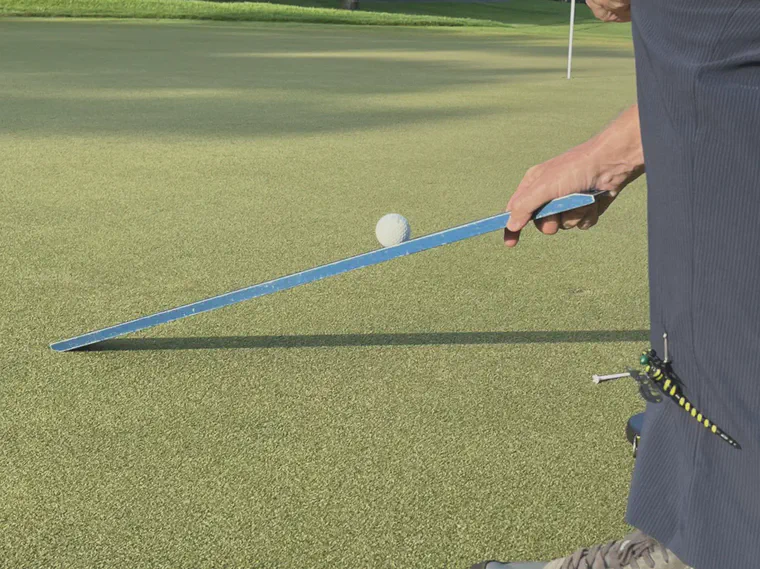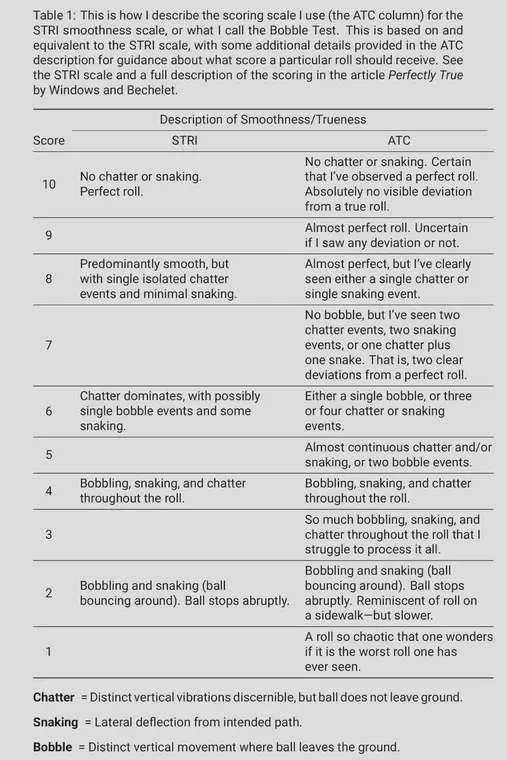Bobble test rating scale
I’ve been playing golf since 1988, and working in greenkeeping since 1993. Depending on who’s reading this, and when, that either makes me an old timer, or it reveals how new and inexperienced I am 😉 😄. Regardless, I’ve been involved with greenkeeping work for more than thirty years now, and with each year that goes by, I find the measurement and recording of playing conditions to be increasingly essential.
“How often should I verticut these greens? What’s a good topdressing schedule? What do you think about brushing?” These are just of few of the questions that I’m often asked about maintenance work. I can only give a general answer. What you can do, if you are keeping a record of the playing conditions,1 is to adjust the verticutting, topdressing schedule, and brushing—among many other things—to either maintain or improve the playing conditions.
By making adjustments at your site, based on the results that are being produced at the moment, the work can be adjusted for your grass, equipment, soil conditions, weather, and every other local variable. The idea is to maximize the number of days in a year with the playing conditions at or above a minimum threshold.2

One of the tests that I recommend now is the bobble test for checking the smoothness and trueness of ball roll. I’ve spent hundreds of hours making thousands of bobble test scores on balls rolled down a stimpmeter. At the end of August, I scored 1,074 ball rolls during the KBC Augusta Tournament.
Over the course of the week, I had the idea that I might make one more attempt to explain how simple and immutable the scoring scale is. I’ve written that up in Table 1, along with the concise scale provided in the Windows and Bechelet classic, Perfectly True.

If I see the ball leave the ground—that is, if there is a single bobble—then the maximum score is 6. If there are two bobbles, the score is 5 or below.
If there is clearly a single, easily identifiable chatter event, or a single, clearly identifiable snaking event, the score is 8.
When there is no bobble, but I see two chatter events, or two snaking events, or a chatter and a snake, then the score is 7. More than two chatters or snakes, or a combination of the two, and the score drops to 6.
A 9 is easy to see too. I haven’t seen a clear bobble or a clear snake, and yet I think the ball might have wobbled or twisted a bit. It wasn’t a perfect roll, yet it was damn close. This is what a lot of really good greens will roll at.
With a 10, there is absolutely no question about there being any deviation. There was not, at least to the eye. The ball rolled perfectly smooth, and perfectly true.
This test is easy to do. It is not about having a score to report to the public. It is to know the effect of maintenance work, and to be able to make a site-specific determination about things like “how often should I verticut” and all those other questions.
For golf course putting greens, the three key playing conditions I recommend keeping a record of are the stimpmeter measurement (green speed), the smoothness and trueness, for which I recommend the bobble test, and green firmness (surface hardness). For more, see the list at the end of this post. ↩︎
I’m writing this with an example specifically for golf. The idea applies to any turf surface—sporting or aesthetic. Find a measurement, or a set of measurements, that assess what the desired conditions are, and then count the number of days in a year in which those conditions are achieved. Then adjust the work to maximize the number of days. ↩︎